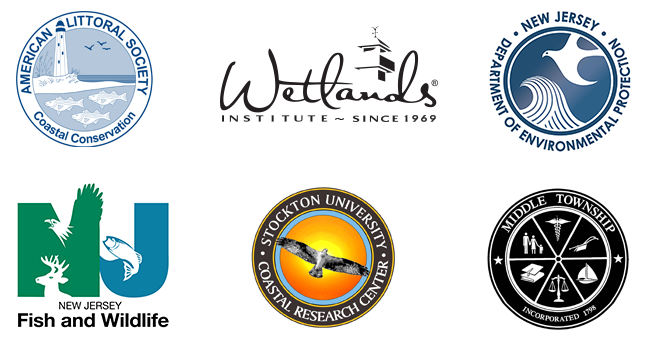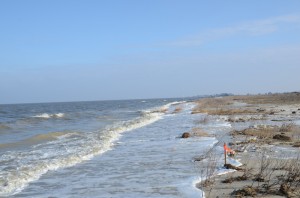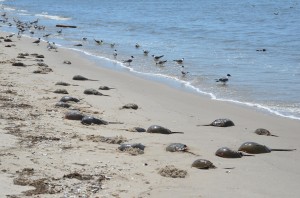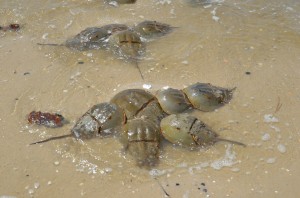Restoring Shorebird Foraging and Horseshoe Crabs Spawning Habitat to Delaware Bay Beaches: Reeds, Cooks, Kimble’s and Pierces Point, NJ
Funded by the National Fish and Wildlife Federation, American Bird Conservancy and the Corporate Wetland Restoration Partnership, the project partners restored nearly one mile of beach in segments that include southern Reeds Beach, Cooks Beach, Kimble Beach, and possibly northern Pierces Point. This project is an ecological restoration project with beach design and specifications based on creating suitable habitat for horseshoe crabs.


Related Media: Association of State Wetland Managers
Delaware Bay Emergency Rubble Removal and Beach Nourishment Project
The Issue:
 The wrath of Hurricane Sandy has unfortunately left significant disturbance along New Jersey’s Delaware Bay coastline. Many of the Bay’s beaches have lost 5ft. or more of sand due to strong westerly winds and intense storm surge. This loss of sand from Delaware beaches left a predominantly mud-based, rubble laden coastline.
The wrath of Hurricane Sandy has unfortunately left significant disturbance along New Jersey’s Delaware Bay coastline. Many of the Bay’s beaches have lost 5ft. or more of sand due to strong westerly winds and intense storm surge. This loss of sand from Delaware beaches left a predominantly mud-based, rubble laden coastline.
The amount of rubble and lack of sand not only causes change in beach aesthetic and profile, but also presents a hardship for Horseshoe Crabs (Limulus polyphemus) that come to spawn on Delaware Bay beaches in the spring. This muddy Delaware coastline was predicted to deter Horseshoe Crab spawning activity as Crabs target sandy beach areas for nest sites. In a study conducted by Wetlands Institute staff, Larry Niles (LJ Niles Associates LLC), Amanda Dey (NJ Division of Fish and Wildlife), and David Mizrahi (NJ Audubon Society), “Second Report: Damage From Superstorm Sandy to Horseshoe Crab Breeding and Shorebird Stopover Habitat on Delaware Bay,” it was found that post-Sandy Delaware Bay spawning beaches saw a reduction of50%-70% aerial coverage of ideal Horseshoe Crab spawning habitat. With Horseshoe Crab populations classified at an all-time low population level with very few signs for recovery, this reduction in adequate spawning area contributes an additional hardship for the Delaware Bay Horseshoe Crab population.
In some areas of the Delaware Bay shoreline, the erosion of sand has exposed rubble creating biological impingement hazards to Horseshoe Crab spawning. These beaches would otherwise provide suitable spawning habitat. Rubble ranges from cedar pilings to small and large size concrete slabs. These impingement hazards are further reducing the available suitable nesting areas for Horseshoe Crabs.
The culmination of sand loss and rubble material not only presents a large problem to the struggling Horseshoe Crab population but also presents an additional threat to Shorebird species such as Red Knots (Calidris canutus), Sanderlings (Calidris alba), and Ruddy Turnstones (Arenaria interpres). This lack of appropriate Horseshoe Crab spawning habitat presents a threat to a critical migration stopover site for Shorebirds. Such Shorebird species depend on the Horseshoe Crab eggs they find along the Delaware Bay to fuel the remainder of their migration to Arctic breeding grounds. A bird that does not consume enough Horseshoe Crabs eggs will simply not be able to breed or even make it to the Arctic.
What the Wetlands Institute Is Doing to Help:
Much has happened and very quickly with this project as the Restoration Team raced against the clock to restore horseshoe crab spawning habitat by April 30th!
Sand from the local land mine company, Albrecht and Heun, in addition to sand from Cumberland County, has been coming to our project area in a constant stream of truckloads since March 18th. Such persistence has helped to fully restore Kimbles Beach, Cooks Beach, Reeds Beach, and Pierces Point. More than 48 tons rubble has been removed from South Reeds Beach alone and more than 23,000 cubic yards of sand has been spread upon these beaches. Pierce’s Point also had old bulkheads and structures removed from the beach. Thanks to Middle Township and The Cape May County Mosquito Commission for their great work on these efforts too.


Taking advantage of the capacity to learn about a first ever Horseshoe Crab beach restoration effort, Wetlands Institute staff have begun conducting research on this project. Before sand was placed along the project area, baseline beach profiles were measured at several points along each of the beach sites within the project area: Reeds Beach, Cooks Beach, Kimbles Beach, and Pierces Point. These beach profiles allow for an understanding on how the beach face originally sloped before restoration activities took place. We conducted a second round of profiling following the restoration work. We will continue to measure the profiles throughout the summer months in order to compare and contrast the reworking of the beach face by normal waves and tides, and any storms. Information will help us to understand how well the original beach restoration shapes worked. Teams from Richard Stockton College Coastal Research Center have been providing detailed survey elevations to support this and other restoration research.

Sand samples were also taken along each profile line (stretching from the dune down to the waterline) to evaluate the moisture content of the sand along different portions of the beach as well as the type and size of the sand, both before and after the restoration. These analyses will also be conducted again after the restored beach has settled, in order to understand how moisture content might have altered along the beach after restoration activities. Such analysis is incredibly important as the survival of Horseshoe Crab eggs within a nest is related to the moisture content of the sand – too much moisture drowns the eggs, not enough and the eggs dry out! This moisture content on a beach is controlled by both sand grain size and elevation or location on a beach. As found in a study conducted by Penn and Brockmann 1994, “Nest-Site Selection in the Horseshoe Crab, Limulus polyphemus,” sediments in the upper parts of Delaware Bay beaches are far too dry for egg survival as most all eggs within that vicinity desiccate or dry up, while nests laid along the lower beach face in wet areas do not have enough surrounding oxygen to survive.

The survival of Horseshoe Crab eggs on Delaware Beaches requires a nice happy medium in a swath of sand where approximately 10 – 18% moisture content exists. Therefore, analyzing the moisture content on Delaware Bay beaches before and after restoration will allow scientists to evaluate whether or not the ideal nesting zone for Horseshoe Crabs has either widened or decreased after restoration. Other members of the restoration team will be collecting, counting and analyzing the health of Horseshoe Crab eggs during nesting season to understand egg density differences along beach elevations. Such analyses will help to quantify the most ideal areas available for nesting along the Delaware Bay beach face. Other research will evaluate which portions of the beach are favored for spawning and how the shorebirds are using these restored beaches.
The Wetlands Institute will stay busy this spring while performing adaptive management activities for this project and providing supporting information to the rest of the research team being led by Larry Niles, shorebird expert, and Amanda Dey, NJ DEP. We are excited to be contributing to this great project and its evaluation to help guide other ecological restoration projects in the future.

